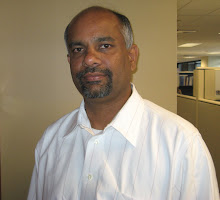I was invited to speak on a panel discussion entitled “Interdisciplinary Design as an Instructional Discipline” at the National Science Foundation (NSF) Engineering Research and Innovation Conference in Honolulu, Hawaii. The theme of the workshop was to foster creativity and innovation in approaches to design by including it as an instructional discipline in academic institutions. Therefore, panelists and invited audience from diverse backgrounds such as architecture, business, product design, information systems, etc. were engaged to provide their perspectives on the design process. The discussion, led by senior industry decision makers from Siemens, Honeywell, PetSmart and Dansk, provided an interesting perspective on issues and challenges facing today’s global and economically turbulent marketplace.
It was interesting to note how the process of design is conducted in disciplines other than information systems and software engineering. There were quite a few commonalities but then there were obvious differences as well. Almost all of the fields do have a multi-step process consisting of conceptual, logical, and physical designs. The difference lies in the interpretation of what constitutes each of these design sub-processes.
I will not elucidate on the design issues that were pertinent to other areas but I will be remiss if I do not highlight the design issues facing our industry today:
We need a design process that consistently facilitates the alignment of the implemented systems with the intent of business. Despite our best effort in trying to come up with a workable design, the rate of failure of IT systems (maybe not systemic failure but nevertheless significant failure) today is quite high. Why is that so? Is it because we err in gathering, analyzing, and/or comprehending the requirements of our business partners? Or is it that our design process is flawed that we fail to realize our system deficiencies well in advance of implementation.
How do we ensure integration in terms of business rules, standards, information flow, process flow, interoperability, etc. across the enterprise? Today, it is not uncommon for businesses to be spread across a much wider geographical and cultural spectrum. Consequently, the varied nature of our system boundaries poses a much greater challenge in integrating our process flows. Could we adjust our design process to take into account these seemingly extraneous factors?
How do we facilitate easy change with the ability to quickly react to market? With the advent of the information age, the market is a much more dynamic entity today when compared to a time twenty years ago. Therefore, not only does our design processes need to be sound but they also need to facilitate a quick entry to market. As the market conditions are forever changing, the design process also needs to be flexible to optimize systems development and maintenance.
How do we ensure all of the above and yet keep pace with increasing technology and programming paradigm sophistication? Adding to the other challenges, the constantly changing technology landscape with increased sophistication in technology paradigms sometimes provide a disruptive influence that needs to be countered to ensure a stable software development process. We can, and should, embrace these new developments but certainly not at the cost of disrupting the enterprise. We are here, after all, to serve the business and no amount of tectonic paradigm shifts should alter our basic focus: supporting the enterprise.
Can we perhaps incubate these ideas into future generations of software designers if academic institutions were to encompass them into a design instructional discipline? Or should such things be learned experientially rather than being advocated in a formal instructional setting?
On the long flight back home, it certainly made me go, “Hmm”.
Monday, June 29, 2009
Subscribe to:
Posts (Atom)
About Me

- Sree Sundaram
- Sree Sundaram is currently a Sr. Director of Enterprise Architecture at a major global technology firm. He is currently engaged at two major international biotechnology firms in optimization and migration of infrastructure from their current platform to a newer technological platform that is in line with their current and future business needs. Sree has solid experience in understanding the needs of both middle and top level management and has the ability to communicate at both levels. He is fundamentally aware that the transactional and short-term needs of middle level management are different from the long-term vision of top-level management. He has successfully dealt with such issues by providing an IT framework that meets both the short term and long term needs. In general, Sree helps to prioritize competing initiatives using a combination of his acumen, communication skills, strategic and operation plans.